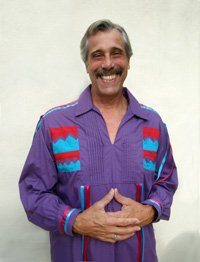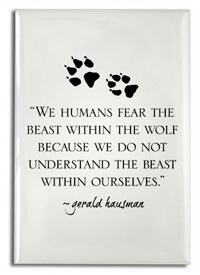By THIRSTY
“We humans fear the beast within the wolf because we do not understand the beast within ourselves.” - from Turtle Island Alphabet by Gerald Hausman.

Gerald Hausman
|
Gerald Hausman spent over twenty years in New Mexico collecting American Indian stories. His more than 70 books evidence his love of folklore, a passion he says that was instilled in him by his mother who painted the portraits of Native American chiefs. He has received 35 awards and honors for his books from the American Folklore Society; Bank Street College; the New York Public Library; the National Council of Social Studies; Parents Choice; Children's Book Council; and, the Society for the Prevention of Cruelty to Children. Some of his books have been adapted for film and many have been used in classrooms around the world. During his award-winning, thirty-five-year career as a storyteller, Hausman has entertained children of all ages at The Kennedy Center, Harvard University, St John's College and in schools across America. He is the author of The American Storybag, a collection of short stories published by Stay Thirsty Press, and the subject of the wolf is never far from emerging in conversations with him. THIRSTY was fortune to catch-up with Gerald Hausman at his home in Bokeelia, Florida for this interview.
THIRSTY: What is there about the wolf that has so fascinated and, at the same time, so terrified man throughout the ages?
Gerald Hausman: One word. Mythology. The wolf is our most misunderstood symbol, creature, friend, enemy. Territorially speaking, we've always had problems with other predators in our proximity. The alpha ape must rule, must play the fool. Not so the wolf. But it's the duality of this animal that's fascinated us. On the one hand, Romulus and Remus and the nurturing mother wolf suckling human babies. On the other hand, the werewolf tearing out our throats. The duality of the wolf in our myths has kept the animal from “being real.” We still don't know what it is.
THIRSTY: The wolf appears in many ancient cultures and traditions, from Norse mythology to Celtic symbolism to Asian roles as symbolic guardians and totems for many Native American peoples. What qualities does the wolf exhibit that have elevated it to such a symbolic or mythic position?
Gerald Hausman: The qualities that come to mind are friendship, patience, teamwork, love, motherliness, fatherliness. cleverness, and fitness. The wolf represents us - at our best. The wolf doesn't represent us at our worst.
THIRSTY: How did your observation about humans fearing the beast within the wolf and themselves come about?
 |
Gerald Hausman: I was writing the books Turtle Island Alphabet and Meditations with the Navajo, interviewing many American Indians, and the wolf kept coming up. We had a friend in Santa Fe named Greg Lonewolf from that famous Pueblo family of artists. I felt a kinship with him and Paul Speckled Rock, Larry Littlebird and others. The wolf motif came up often. Along with the eagle, the turkey - the latter being the beloved first world person of Indian America. Wolf and dog both are primal symbols in the Americas. One day I just wrote the chapter on the wolf based on the things my friends had been saying. Later on, the quote was picked up by the media - first a telecommunications company known to all of us. They didn't want to pay anything for the use of my words (I would've immediately donated the money to a wolf cause) but the man who contracted the use of it said, “You won't need money from us, your quote will reach millions of people when we release it.” And, thankfully, so it has. I am making donations as we speak. This one-line wolf quote has sold more books of mine than all the sales teams that have represented our books.
THIRSTY: During your career as an award-winning author, Native American stories have played a significant role in many of your books. When did you first learn about the importance of the wolf to the Native American culture? And, how did it affect you personally?
Gerald Hausman: I have to say, quite simply, the Cub Scouts. My mom brought us, my brother and me, to American Indian storytellings. The early Boy Scouts used the wolf as its primary logo. Listening to storytellers with the surname of Wolf was an eye-opener to an eight-year-old boy. Then to find out that wolves talked like we did, that was a real ear opener.
THIRSTY: The wolf has been the subject of folk tales like The Boy Who Cried Wolf and Little Red Riding Hood, and also the star of movies like White Fang, and the book-play-film-symphony, Peter and the Wolf. The wolf is an iconic symbol in such internationally beloved books like The Call of the Wild. Has the role of the wolf become overused or commonplace in today’s hyperactive, computer-driven society?
Gerald Hausman: The wolf is always abused and almost never used without some level of fright. Humans love to be frightened. We live for fear, I think. Everything comes to us as a warning - “Don't touch that” is the first thing you hear from parents. Who would go to a movie about the kindly wolf that fixed Wall Street and cured cancer? Wolves move in packs; so do humans. It scares us just to think that wolves do teamwork better than we do. Consider this: they've never gone to war, and won or lost. Only humans do that. But not well.
THIRSTY: Has your observation about the beast within the wolf resonated with others?
Gerald Hausman: So far. I'm always surprised at how often someone writes and says, “Are you the one who said . . .” Well, I didn't really say it, I wrote it. It came from the heart because at the time my brother's hybrid wolf spent a lot of time at our house. She used to see me off running the arroyos in Tesuque, New Mexico, and from a great distance she'd come loping because she wanted to join me. I feel a deep kinship with all life, but especially the four-footed. I guess I feel I am one of them. That is what I try to convey (with my wife Loretta) in our books. It's the oldest of messages and yet the most slippery for humans to grasp - we are one.
THIRSTY: We often think of the wolf in negative terms. Is there a reason to think positively about the wolf, especially in the areas of animal management and wildlife conservation?
Gerald Hausman: All creatures great and small are there for mutual continuance, not terminance. We haven't the right to declare war on any species, least of all our own. Even the fire ants in Florida keep a measure of distance between us and them. If they are among the First People, as some of my Navajo friends say, then we must be joined at the hip because they have as fierce a bite as we do. Poet Robinson Jeffers once wrote, “I'd sooner, save the penalties, kill a man than a hawk.” I feel this way about wolves. Wolves are part of the great balancing system of Mother Earth and Father Sky, of First Man and First Woman. Wolf was named “Great Wanderer” by the Navajo. Unfortunately we've fenced the wolf's range to keep sheep and cattle for human consumption and we've used Great Wanderer's hunting ground as our playground. We honor ourselves with the Biblical-given right of dominance. But that doesn't make it right.
THIRSTY: You have granted permission for your wolf quotation to appear on a few products. What do you hope will be achieved with a wider dissemination of this observation?
Gerald Hausman: I hope that people take another look and allow another thought about Great Wanderer. I also hope that we hold the mirror to our own nature which has more than enough darkness to be sifted and ultimately understood.
Links:
Gerald Hausman - Author & Storyteller
Gerald Hausman is the author of The American Storybag

